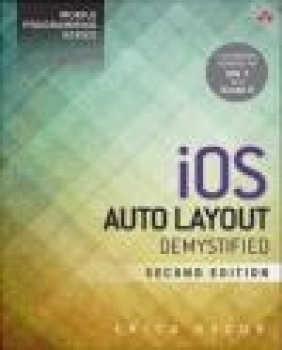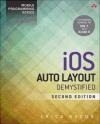iOS Auto Layout Demystified
Erica Sadun
iOS Auto Layout Demystified
Erica Sadun
- Producent: Addison Wesley Publishing Company
- Rok produkcji: 2013
- ISBN: 9780321967190
- Ilość stron: 288
- Oprawa: Miękka
Niedostępna
Opis: iOS Auto Layout Demystified - Erica Sadun
Completed Updated for iOS 7 and Xcode 5 Auto Layout transforms the way you create iOS user interfaces. As flexible as it is powerful, Auto Layout gives you unprecedented control over your iOS user interfaces. But Auto Layout has a reputation for difficulty. In iOS Auto Layout Demystified, Second Edition, world-renowned iOS developer and author Erica Sadun strips away the confusion, helping you gain Auto Layout mastery the easiest way possible: by example. Fully updated for iOS 7 and Xcode 5, this tutorial delivers everything Sadun's guides are famous for: clear explanations, expert tips, proven best practices--and, above all, plenty of code to learn from and reuse. Step by step, Sadun explains how Auto Layout "thinks," how it works, where it fits, and why it's more useful (and simpler) than you ever imagined. She offers practical solutions for a wide variety of real-world iOS development challenges, plus innovative ways to use Auto Layout to build interactive elements, animations, and more. If you're an experienced iOS developer, this guide will expand your design possibilities, helping you build apps that are superbly usable and intuitive and stand out even in the most crowded marketplace. Coverage includes * Mastering Auto Layout's basic concepts, techniques, and approach* Defining unambiguous, satisfiable constraints that express your layout exactly how you intend* Overcoming obstacles to constraint-based user interface design in Interface Builder* Using visual formatting to express how items are laid out vertically and horizontally* Making visual formats more flexible with metrics dictionaries and layout options* Debugging constraints and deciphering those bewildering Xcode log messages* Using descriptive techniques to uncover and express natural relationships in your design* Applying iOS Auto Layout techniques in Mac OS X apps tooPreface xiii Chapter 1: Introducing Auto Layout 1 Origins 1 Saying "Yes" to Auto Layout 2 Geometric Relationships 3 Content-Driven Layout 5 Prioritized Rules 6 Inspection and Modularization 6 Incremental Adoption 6 Constraints 7 Satisfiability 7 Sufficiency 8 Constraint Attributes 11 About Those Missing Views 12 Underconstrained Missing Views 13 Missing Views with Inconsistent Rules 14 Tracking Missing Views 14 Ambiguous Layout 15 Exercising Ambiguity 16 Visualizing Constraints 17 Intrinsic Content Size 18 Compression Resistance and Content Hugging 20 Image Embellishments 22 Alignment Rectangles 22 Visualizing Alignment Rectangles 24 Alignment Insets 24 Declaring Alignment Rectangles 26 Implementing Alignment Rectangles 27 Exercises 29 Conclusions 30 Chapter 2: Constraints 31 Constraint Types 31 Priorities 33 Conflicting Priorities 33 Enumerated Priorities 34 Content Size Constraints 36 Intrinsic Content Size 36 Content Hugging 36 Compression Resistance 38 Setting Content Size Constraints in Code 39 Setting Content Size Constraints in IB 40 Building Layout Constraints 41 The Layout Constraint Class 42 Constraint Math 42 First and Second Items 43 Creating Layout Constraints 44 Building NSLayoutConstraint Instances 45 Unary Constraints 45 Zero-Item Constraints Are Illegal 46 View Items 47 Constraints, Hierarchies, and Bounds Systems 48 Installing Constraints 50 Removing Constraints 52 Comparing Constraints 54 Matching Constraints 55 Laws of Layout Constraints 57 Exercises 59 Conclusions 59 Chapter 3: Interface Builder Layout 61 Designing in IB 61 Disabling Auto Layout 62 Opting Out of Auto Layout in Code 63 Combining Autosizing with Auto Layout 64 Basic Layout and Auto-Generated Constraints 64 Inferred Constraints 64 Ambiguity Resolution Constraints 67 Size Constraints 69 A Guided Tour of IB Elements 69 Constraint Listings 76 Xcode Labels 78 Adding Xcode Identities 79 Adding Constraints 80 Dragging 81 Pinning and Aligning 83 Previewing Layouts 85 Inspecting Constraints 88 View Size Inspector 90 Frame and Layout Rectangles 91 Other Size Inspector Items 92 The Resolution Menu 92 Updating Frames and Constraints 92 Adding and Resetting Constraints 93 Clearing Constraints 93 Constraints/Resizing Pop-Up Menu 93 Descendants 94 Siblings and Ancestors 95 The Missing Views Problem 95 Balancing Requests 97 Hybrid Layout 100 Building a Nib File for Testing 100 Adding the Nib File in Code 101 Advantages of Hybrid Layout 102 Removing IB-Generated Constraints 104 Exercises 105 Conclusions 108 Chapter 4: Visual Formats 109 Introducing Visual Format Constraints 109 Options 111 Alignment 112 Skipping Options 113 Variable Bindings 113 The Problem with Indirection 113 Indirection Workaround 114 Metrics 115 Real-World Metrics 115 Format String Structure 116 Orientation 116 Retrieving Constraints by Axis 117 View Names 117 Superviews 118 Connections 118 Empty Connections 118 Standard Spacers 119 Numeric Spacers 120 Referencing the Superview 120 Spacing from the Superview 122 Flexible Spaces 122 Parentheses 123 Negative Numbers 124 Priorities 124 Multiple Views 125 View Sizes 126 Format String Components 128 Getting It Wrong 130 NSLog and Visual Formats 131 Constraining to a Superview 132 View Stretching 133 Constraining Size 134 Building Rows or Columns 135 Matching Sizes 136 Why You Cannot Distribute Views 137 How to Pseudo-Distribute Views (Part 1: Equal Centers) 138 Pseudo-Distributing Views (Part 2: Spacer Views) 140 Exercises 143 Conclusions 143 Chapter 5: Debugging Constraints 145 Xcode Feedback 145 Development Feedback 145 Compiler Feedback 146 Runtime 146 Reading Console Logs 147 Autosizing Issues Example 147 Solution: Switch Off Autosizing Translation 148 Auto Layout Conflicts Example 149 Solution: Adjusting Priorities 150 The Nuclear Approach 150 The Balance Approach 151 Tracing Ambiguity 151 Examining Constraint Logs 152 Alignment Constraint Example 152 Standard Spacers Example 153 Equation-Based Constraint Example 153 Complex Equation Example 154 Multiplier and Constant Example 155 A Note About Layout Math 155 Constraint Equation Strings 156 Adding Names 159 Using Nametags 160 Naming Views 161 Describing Views 161 Unexpected Padding Example 164 The Hugged Image Example 165 View Centering Example 166 Retrieving Referencing Constraints 167 Descent Reports 169 Ambiguity Example 170 Expanding on Console Dumps Example 172 Visualizing Constraints 173 Automating Visualization 174 Launch Arguments 175 Internationalization 177 Doubled Strings (iOS/OS X) 177 Flipped Interfaces (OS X) 178 Flipped Interfaces (iOS) 179 Profiling Cocoa Layout 181 Auto Layout Rules of Debugging 183 Exercises 183 Conclusions 184 Chapter 6: Building with Auto Layout 185 Basic Principles of Auto Layout 185 Layout Libraries 186 Building Libraries 187 Planning Interfaces 190 Building for Modularity 191 Updating Constraints 194 Calling Updates and Animating Changes 195 Animating Constraint Changes on OS X 196 Fading Changes 197 Designing for Edge Conditions 198 Building a View Drawer 200 Building the Drawer Layout 203 Managing Layout for Dragged Views 206 Dragged Views 207 Window Boundaries 208 Exercises 211 Conclusions 211 Chapter 7: Layout Solutions 213 Table Cells 213 Auto Layout and Multiple-Height Table Cells 216 Preserving Image Aspect 217 Accordion Sizing 220 Scroll Views 221 Scroll Views and Pure Auto Layout 222 Hybrid Solution 222 Building a Paged Image Scroll View 223 Centering View Groups 226 Custom Multipliers and Random Positions 228 Building Grids 231 Making Room for the Keyboard 233 Inserting Views at Runtime 236 Adding iOS Frame and Constraint Overlays 237 Motion Effects, Dynamic Text, and Containers 238 Exercises 238 Conclusions 238 Appendix A: Answers to Exercises 241 Chapter 1 241 Chapter 2 242 Chapter 3 243 Chapter 4 245 Chapter 5 247 Chapter 6 248 Chapter 7 249 Index 251
Szczegóły: iOS Auto Layout Demystified - Erica Sadun
Tytuł: iOS Auto Layout Demystified
Autor: Erica Sadun
Producent: Addison Wesley Publishing Company
ISBN: 9780321967190
Rok produkcji: 2013
Ilość stron: 288
Oprawa: Miękka
Waga: 0.44 kg






























